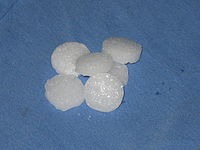- Mothball
-
Mothballs are small balls of chemical pesticide and deodorant used when storing clothing and other articles susceptible to damage from mold or moth larvae (especially clothes moths like Tineola bisselliella).
Their use when clothing is stored out-of-season gave rise to the colloquial usage of the terms "mothballed" and "put into mothballs" to refer to anything which is put into storage or whose operation is suspended.
Contents
Composition and safety
Older mothballs consisted primarily of naphthalene, but due to naphthalene's flammability, modern mothballs use 1,4-dichlorobenzene instead. Both of these ingredients have a strong, pungent odor often associated strongly with mothballs. 1,4-Dichlorobenzene and naphthalene should not be mixed as they react chemically to produce a liquid which may cause damage to items being preserved.[1] Camphor, an insect repellent, can also be used in mothballs.
Both chemicals kill moths and moth larvae with the vapor. Both naphthalene and 1,4-dichlorobenzene sublimate, meaning they evaporate from a solid state to a gas; this gas is toxic to the moths.
For either of these chemicals to be effective, they need to be placed with the clothing in a sealed container so the vapors can build up and kill the moths. In a sealed atmosphere like this, the vapors are not harmful to people because they are contained. The main threat would occur when opening the containers, or from wearing clothes immediately after opening (especially a problem for infants). A solution is to open the containers outside and let the clothes hang and air out for a day before wearing.
Uses and risks
In addition to repelling insects such as moths and silverfish, mothballs are used as a stovepipe cleaner, snake repellent, and to keep away mice or other pests.[2] Mothballs have also been used by some campers to keep bears away from their food or even their entire campsite.[citation needed]
The main concern about the use of mothballs as a snake, mouse, or animal repellent is their easy access to children, pets, and beneficial animals. Leaving them in a garden or in a living space unprotected makes it very easy for unintended victims such as children and pets to gain access to them. Mothballs are highly toxic when ingested, causing serious illness or death. In addition to this, using a very large quantity of mothballs in a basement or a living space may cause serious respiratory problems in people living in the space.[3]
Mothballs are a neurotoxin - especially those made of paradichlorobenzine - and needs to be treated as such.
It has also been suggested that the toxic chemical in mothballs will bond to garden soil, causing damage to it.[citation needed] Research has shown that a weak bond can occur, but naturally occurring soil microbes will break down the toxic component of mothballs over extended periods of time.[citation needed] In addition to this, the toxic effects of mothballs may also kill beneficial soil insects while it is present in soil.[4]
Mothballs have been used for solvent abuse by adolescents.[5][6] Mothballs have also been found to be a carcinogen.[7] Older formula mothballs have also been used by drag racers to enhance the octane value of petrol by dissolving the mothballs in some of the fuel and filtering out the remains with a filter paper.
In the Mythbusters episode "Scuba Diver, Car Capers", it was shown to be "plausible" that adding mothballs to a car's fuel tank would increase its horsepower.
See also
- Mothball fleet
References
- ^ "Collecting and Preserving Insects and Mites: Tools and Techniques". United States Department of Agriculture - Agricultural Research Service. http://www.ars.usda.gov/Main/site_main.htm?docid=10141&page=11. Retrieved 26 June 2011.
- ^ Uncommon Uses for Common Household Products. Frank W. Cawood and Associates. 2000. p. 126. ISBN 1890957399. http://books.google.com/books?id=vYo8rdgNte0C.
- ^ "National Pesticide Information Center"
- ^ "Eco-USA:Naphthalene"
- ^ "Mothball sniffing warning issued", BBC News, 27 July 2006.
- ^ "Twin Girls with Neurocutaneous Symptoms Caused by Mothball Intoxication", The New England Journal of Medicine, July 27, 2006.
- ^ "Scientists May Have Solved Mystery Of Carcinogenic Mothballs", Physorg.com, June 20, 2006.
External links
Categories:- Insect repellents
- Pesticides
- Household chemicals
Wikimedia Foundation. 2010.

